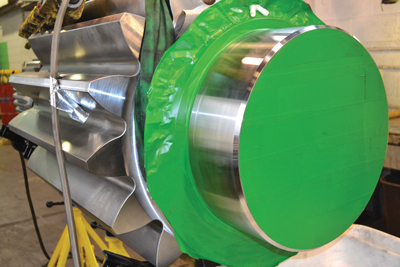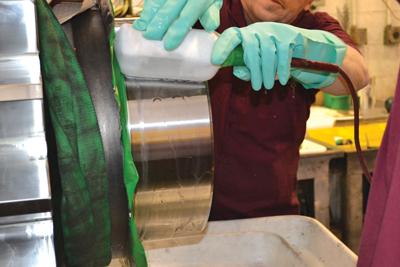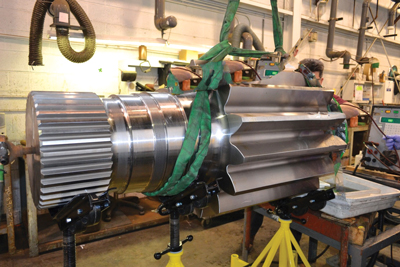 |
 |
 |
| By repairing the pinion gear of a dragline in situ with the SIFCO Process, industrial gearing manufacturer Horsburgh & Scott Co. was able to return the machine to service with minimal downtime while extending the service life of the gear components. |
Horsburgh & Scott Co., based in Cleveland, Ohio, USA, designs, manufactures, services, and rebuilds industrial gearing and gear drives for industry-specific needs. The company has a long-standing relationship with SIFCO ASC, a major supplier of contract electroplating and anodizing services, having worked with them for 20 years to solve various component repair issues. SIFCO ASC is a division of U.K.-based Norman Hay plc, a global chemicals, sealants, surface coatings and engineering group.
In many types of large mining equipment, a pinion gear is an essential part of gear train assemblies. If not maintained regularly, lubricant for pinion gears can leak out through a bearing seal and potentially cause the bearing to seize and gall the bearing journal. Removal of the seized bearing often results in additional gouging damage to the bearing journal surface. In a recent repair procedure, the pinion gear in question was part of the boom drive mechanism of a dragline owned by a coal producer. Its bearing journal had acquired a gouge that was 0.030 in. deep, 0.75 in. wide and 12 in. long; in addition, the journal was 0.012 in. undersize.
This type of damage is usually resolved by component replacement or by repairing the damaged area. Typical repair options include sleeving, welding, metal spray and tank plating. Component replacement can be costly and may take four to six weeks. Welding can weaken the strength of the substrate. All of these repair processes require the part to be removed from the equipment and taken off-site for both pre-processing machining operations to remove the defects in the journal (making the journal a minimum of 0.060 in. undersize) and then post-processing machining operations for dimensional restoration.
Horsburgh & Scott Co., with a heritage dating back to the 1870s, has extensive experience in successfully repairing and rebuilding more than 90 varieties of gearing manufacturers’ brands from around the world, and is well qualified to identify the most cost-effective and robust methods of repair—in this case selecting SIFCO Process, a portable plating process used to selectively electroplate localized areas. With this approach, defects are typically repaired with one or more layers of copper, and then covered with a wear-resistant deposit.
In this instance, nickel in the 30 Rockwell hardness range was selected as the final deposit because it was similar to the hardness of the original base material and provided the necessary wear properties. Copper was chosen for the fill material because it has excellent “throw” power (the ability of the plated deposit to reach into deep grooves or other defects), is easy to reactivate when building up multiple layers, and as a softer fill material is easy to dress down between layers.
For this application, in which the gouge in the journal was filled with copper, no machining was required and only one layer of nickel was plated to achieve the desired journal dimension. This, according to the company, resulted in a repair that was significantly less expensive than other alternatives requiring pre- and post-process machining.
The bearing journal was first plated with 0.001 in. of copper and then masked for the defect repair. The gouge was filled with three layers of copper and hand finished in between each layer. Once the gouge was repaired, the outside diameter was plated with 0.006 in. of nickel.
Dave Niederhelman, chief metallurgist at Horsburgh & Scott Co, said, “In this application, the SIFCO Process has extended the working life of the gear and improved the failure rate due to the nature of the nickel coating on the journal. The cost of manufacturing and material to replace the gear would have been expensive in comparison, as well as causing weeks of downtime.”
Lee Shelton, managing director of SIFCO ASC, said, “The portability of the SIFCO Process makes it a versatile solution used for numerous demanding repair and OEM applications. The localized plating process works well in an industrial environment. The plated deposits withstand considerable stress and strain, while maintaining excellent adhesion.”






